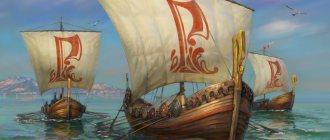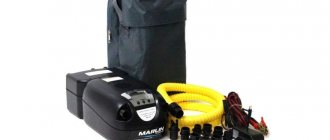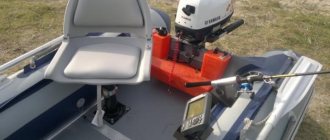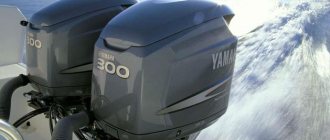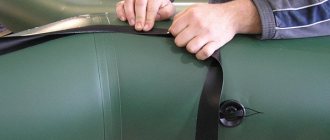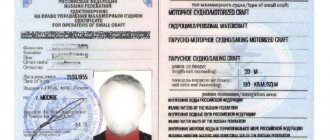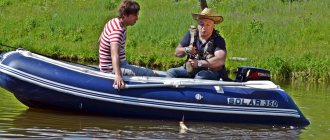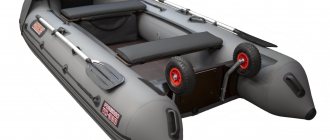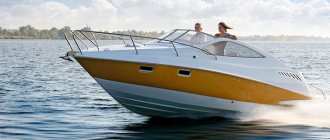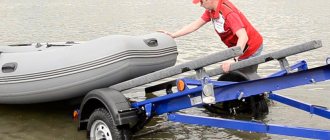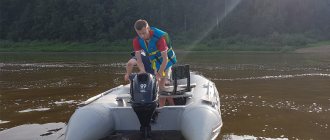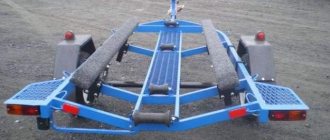The range of PVC boats with NDND has recently expanded significantly, and domestic manufacturers occupy a significant share in the segment of small boats. Products of Russian companies are able to compete with foreign analogues, and are not inferior to them in quality, and have a very attractive price for lovers of active recreation on the water. Large manufacturing companies are actively conquering foreign markets and offering their own unique developments.
The main activity of the company, founded in 1993, is related to the development and manufacture of inflatable PVC boats. Small boats produced under the Boat Master brand are made from high-quality materials and components. The Taimen and Riviera models have gained recognition among fishermen and hunters due to their excellent technical characteristics. They have a large carrying capacity, excellent maneuverability on water, have an increased cylinder diameter and are distinguished by a high level of reliability.
We glue a PVC boat with our own hands
1
) degrease the joints with acetone;
2
) coat both surfaces with PVC glue, including hardener, after which the product should be put aside for 20–30 minutes;
3
) we heat both surfaces with a construction hairdryer and connect them together;
4
) roll with a roller for rolling polyvinyl chloride coatings. When the hull is ready, you should glue all the necessary parts - for example, the inflatable neck, seat mounts, transom and other structural elements of our watercraft. Here the only limitations are our imagination and design features. It is important to maintain symmetry, since redoing will be expensive. If you do everything gradually and carefully, you will get a very valuable inflatable boat. Before testing the vessel, it should be tested under load. To do this, you need to inflate the boat and walk along its sides. After this, the watercraft should not begin to leak air in any places at all - in this case, we can assume that the sizing was successful and proceed to testing in an open reservoir. However, when going out on a boat for the first time, you should not sail far from the shore. And then - practical tests - we go directly to fishing.
The pattern drawing shows a simple model with which it is recommended to start making a boat with your own hands. After acquiring the necessary skills and experience, you can move on to creating more complex models
:
Here you can download
Each of these methods has its own advantages and disadvantages, so in each specific case the most appropriate one is chosen.
With mechanical cutting methods, the time required is 5-10% of the total boat manufacturing time.
In mass production, the flat cutting method is used, which allows you to simultaneously cut out 10 - 20 parts of the same configuration. Laser cutting and cutting with a water jet are promising for the flat method, in which cutting out the contours of parts can be carried out according to a given program. Cutting material using a laser beam provides cutting speeds of up to 30 m/min and cutting accuracy of ± 0.5 mm. With this cutting method, the edges of parts made of synthetic fabrics are melted and have a clear edge. When cutting, the material is held in place by a vacuum.
Recently, the technique of cutting rubberized fabrics with a jet of water has opened up great possibilities. The essence of the method is that water is compressed to a pressure of about 400 MPa, and then thrown out in a thin stream through a sapphire nozzle with a diameter of 0.1-0.3 mm. The water jet, which has a very high speed, easily cuts the material. Polymer additives or abrasive particles are sometimes added to a system with ordinary tap water. The cutting speed, depending on the material, can reach 60 m/min. The reactive force in the nozzle due to the low water flow rate (0.5 - 4 l/min) is insignificant, therefore industrial robots can be used with this method.
On the cut panels, mark the places where they are glued together and where the parts are glued. To remove excess dusting material from gluing areas and create a rough surface in order to increase gluing strength, roughening is used, i.e., removing a very thin layer of rubber lining. Parts with straight sections are roughened on roughening machines, and parts with complex configurations are roughened using manual roughening elements. The duration of roughening in the general boat manufacturing process ranges from 5 to 15%.
However, the roughening process is labor-intensive, and for thin fabric shells it can lead to loss of textile strength and seal failure. In recent years, work has been especially intensive to eliminate this process by selecting new powder materials that are easily washed off with solvents and using stronger adhesives. The rough surface, on at least one side of the fabric, may be formed by evenly spaced indentations in the form of intersecting lines, which are formed simultaneously with the vulcanization of the fabric. An interesting solution seems to be when an abrasive material is introduced into the glue, which, when rolling the parts to be joined, penetrates into the surfaces to be glued together like “rivets”.
The success of gluing is determined by good surface preparation and a smooth, wrinkle-free and bubble-free connection of the bonded surfaces. Before gluing, mark the boundary of the material application. The surfaces to be glued are connected starting from one edge of the seam to the other or from the middle to the edges so that there are no wrinkles or bubbles. The seam is smoothed by hand or rolled with a roller. On long seams, in order to avoid uneven stretching of fabrics, marks are applied in advance to both glued surfaces after 30 - 50 cm. Seams several meters long are glued in parts of 1 -1.5 m. You can lay lavsan or fluoroplastic film or pieces of plexiglass between the glued surfaces, which can be removed as parts are connected. Most often, the joining of panels is carried out using one-time or repeated coating of the glued areas with mainly cold-curing glue. In the manufacture of heavy-duty, large-sized boats, hot-curing adhesives are used, followed by pre-pressing and vulcanization of the seam in a vulcanization press. Apply the glue manually or using a mechanical adhesive spreading device. Before coating with glue, the surfaces for gluing are refreshed with an organic solvent (gasoline, ethyl acetate, a mixture of them, etc.) - After refreshing with the solvent and after each application, the surfaces are dried.
Assembling the shell of a homemade inflatable boat begins from the sides and is carried out in strict sequence. The individual parts are connected in the established order with various seams (mostly overlapped) along the coated edges, to which, on both sides, to eliminate the effect of air filtration along the fibers of the fabric, pre-glued tapes 25 - 40 mm wide made of rubberized fabric are glued (Fig. 4.1)
, often thinner than the side fabric. When using hot-curing adhesives, seams are sealed with tapes made of unvulcanized rubber or rubberized fabrics.
The production of PVC boats as a business has long become popular. The profitability of such a project in certain seasons reaches good levels, and reviews from the workshop owners and the clients themselves indicate a constant demand for the products.
Is it worth opening such a production and what is needed for this? Many questions frighten entrepreneurs at first, especially new ones. But all the nuances can be sorted out gradually. Moreover, this process is unhurried. The main thing is to maintain the quality of manufactured products at a decent level.
This is one of the leading manufacturers of various types of inflatable boats. The production base of the enterprise is located in Ufa, Republic of Bashkortostan. Products of this brand attract consumers with their simplicity of design, light weight and affordable price. Boats produced by AquaMaster have three lines: Aqua, Aqua-Master and Aqua-Optima.
LLC "PARUS"
This company is a designer and manufacturer of inflatable boats. Its production facilities are located in Ufa. The watercraft of this brand are famous for their reliability, simplicity of design and ease of operation and storage, and are popular among people who prefer active recreation on the water. For the manufacture of boats, high-strength PVC-reinforced fabrics from foreign manufacturers are used. The company is known not only in Russia, but also abroad.
Ukrainian factories
Adventure Boats is a well-known Kiev company producing inflatable rubber boats. Its products have excellent reviews from Ukrainian fishermen.
The production is almost twenty years old. It all started with a small workshop and primitive handicraft production. The enthusiasm of the owners was able to promote the brand and make it the most popular product among fishermen these days.
The plant operates and complies with all international standards of quality, reliability and design. High-quality accessories and components are used. The material used is of the appropriate level. The company uses polymers as the main material, and they ensure high tightness of the products.
Technologists have developed their own technology for welding with hot air and spot ultrasound. This increased the strength of the product by 2-3 times than that of competitors’ analogues.
The plant operates on expensive equipment and has a competent staff of craftsmen. The main value of this manufacturer is user safety! At the same time, the price range of boats starts from approximately $186 and above. The products are available even to low-income citizens. The most popular models are Adventure - Scout S-250 and Adventure T-270.
BARK boats are a little more expensive. They are also produced in Ukraine. They are purchased by the most demanding customers when it comes to quality.
The company produces several modifications. High-strength synthetic materials are used in their production. Thanks to the latest production technology, they are distinguished by excellent driving performance, reliability and versatility.
Inflatable boats "BARK" are made by hand, and handmade work is always appreciated and distinguished by quality. Their special quality is their light weight and compactness when deflated.
The quality certificate of this brand satisfies Russian and Belarusian legislation.
Production is located in Dnepropetrovsk. Popular BARK models are B-240C and B-260N. Another Dnepropetrovskaya. It produces boats STORM, RIB AMIGO, MAGELLAN and exports them to 16 countries, including the countries of the European Union. The main material is German and Korean PVC fabrics.
Under the brand of the same name, this manufacturing enterprise produces various models of inflatable boats. The company has gained a good reputation in the small boat market, and is distinguished by its stability and constant expansion of its product range. Inflatable boats "Monsoon" are high-tech products that are produced using modern equipment. Reduced production costs allow us to set friendly prices. For production, PVC fabric is used, which has unique characteristics, which makes it possible to operate watercraft in conditions of low temperatures.
This manufacturer from Ufa specializes in the production of inflatable boats under the same name. For their manufacture, high-quality PVC fabric is used, which has increased strength. Inflatable boats "Alpha" are the lightest among representatives of their class. They are equipped with oarlocks for installing rotary oars and handles for carrying. The watercraft is packed in one case, which greatly simplifies its storage and carrying.
This young company from Ufa has proven itself in the field of production of PVC inflatable boats. For their manufacture, special reinforced PVC fabric from foreign manufacturers is used. It has unique performance characteristics, which expands the possibilities of using boats. ]UfaBriz[/anchor] produces lightweight watercraft that are easy to assemble and easy to transport and store. Optimization of production processes allows the company to set affordable prices for its products.
Russian rubber boat factories
The factories in Ufa and Yaroslavl are the oldest Russian manufacturers of inflatable boats .
They prefer to use rubberized fabric in production.
There is a decent range of models, most of them are double and single boats.
Their main advantages are lightness and affordable price. This is due to low-quality material and antediluvian design.
But there are attempts to keep up with progress. Models with space for a motor are available. Everyone knows the ORION boat. These factories are trying to start producing PVC boats. The most famous model of the Ufa plant is ARGO.
company in the production of rubber boats is the St. Petersburg company.
There are many PVC models available. The boats are of excellent quality, of different types - from rowing boats to RIB boats. The most famous Russian boat company is PFK Mnev and K LLC.
On the market since 1994. Products of excellent quality, reasonable price. These boats took part in sports races many times and brought prizes to athletes.
The boat YAMARAN is produced by order of the Japanese company Yamaha. Reviews about this project are positive.
